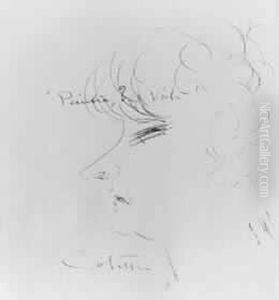Sidonie Gabrielle Colette Paintings
Sidonie Gabrielle Colette, born on January 28, 1873, in Saint-Sauveur-en-Puisaye, Yonne, Burgundy, France, was a prolific French author, renowned for her novels, short stories, and a distinctive voice that brought to life the complexities of relationships and the nuances of gender and sexuality. Colette's literary career spanned over half a century, during which she emerged as a leading figure in the Parisian literary scene and became known for her vivid depictions of love, sensuality, and female independence.
Colette's early works were published under the pseudonym Willy, a name belonging to her first husband, Henry Gauthier-Villars, a well-known critic and writer himself. This collaboration produced the 'Claudine' series, semi-autobiographical novels that became immensely popular for their candid portrayal of a young woman's sexual awakening and rebellion against societal norms. Eventually breaking away from her husband's shadow, Colette began publishing under her own name, earning critical acclaim and a reputation as a formidable talent in her own right.
Among her most celebrated works are 'La Vagabonde' (1910), which reflects Colette's own experiences as a mime and actress, and 'Chéri' (1920) along with its sequel 'The Last of Chéri' (1926), both exploring themes of love, aging, and the interplay between youth and experience. Colette's writing was groundbreaking in its exploration of gender fluidity and bisexuality, themes that were considered avant-garde at the time.
Colette's contributions to literature extended beyond her novels. She was also a talented journalist, writing for several leading French newspapers and magazines, and a stage performer, which influenced her literary works. Her personal life, marked by her relationships with both men and women, was as unconventional as her writing, and she never shied away from incorporating elements of her experiences into her work.
In 1948, Colette was nominated for the Nobel Prize in Literature, a testament to her lasting impact on the literary world. She continued to write until her death on August 3, 1954, in Paris. Colette's legacy lives on through her rich body of work, which continues to inspire and provoke discussion around the themes of gender, sexuality, and personal freedom. Her home in Paris, where she spent her final years, is now a museum dedicated to her life and work.



